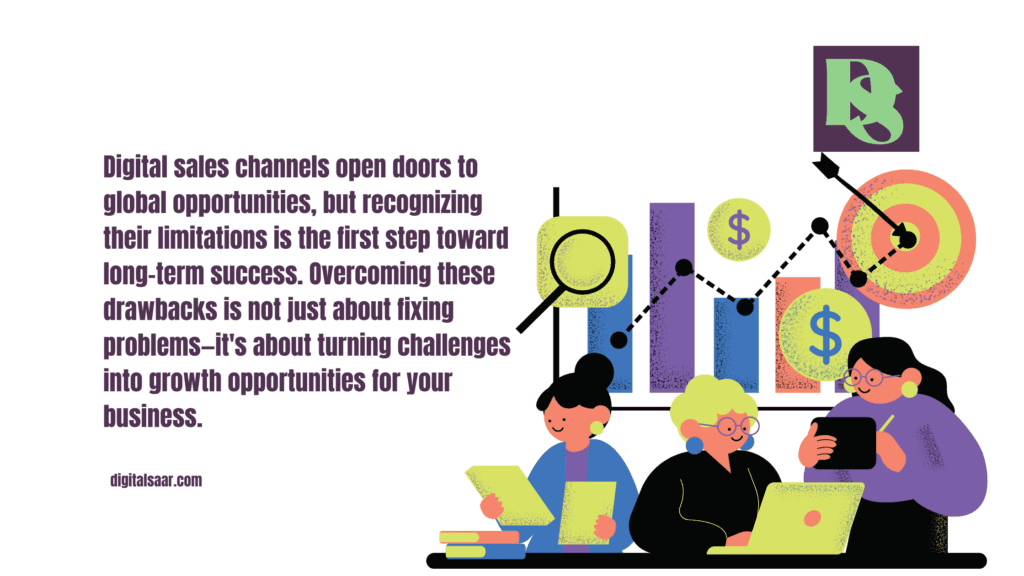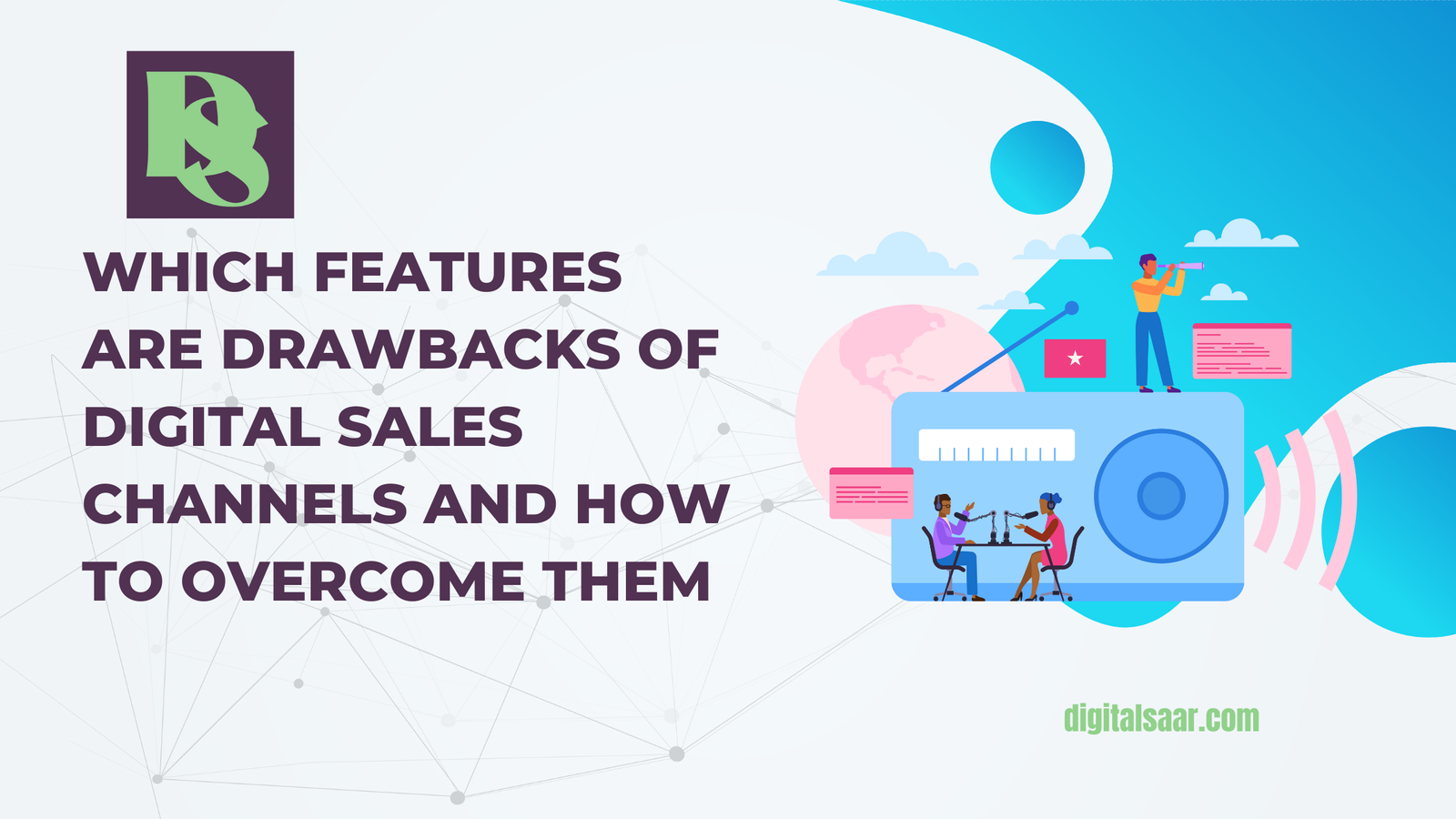When considering which features are drawbacks of digital sales channels, it’s important to recognize that not everything about selling online is as smooth as it seems. While these platforms offer convenience and a wider reach, they also come with obstacles that can affect your business’s growth. From security risks to a lack of personal touch, we’ll explore the common pitfalls of digital sales channels and what they mean for your success. Understanding these challenges will help you navigate the online market more effectively.
Which Features Are Drawbacks Of Digital Sales Channels?
Digital sales channels offer many benefits, but they also come with challenges. Below are some key drawbacks that businesses need to be aware of:
Over-Automation and Lack of Personalization
- Over-reliance on automated systems like chatbots and pre-set responses can feel impersonal.
- Customers may miss the human touch, leading to lower satisfaction and reduced loyalty.
- Without personalization, brands risk losing connection with their customers, making it harder to retain them.
Limited Product Interaction
- Customers cannot physically see, touch, or try products before purchasing.
- This limitation often leads to hesitation in buying, higher cart abandonment rates, or increased product returns.
- Images and descriptions may not fully capture the product, causing dissatisfaction post-purchase.
Security and Privacy Concerns
- Digital platforms are prone to cyber threats like data breaches and hacking.
- Customers may hesitate to share personal and payment details, fearing fraud or misuse of their data.
- A single breach can severely damage a business’s reputation and erode trust with its customers.
Increased Competition and Price Wars
- Digital platforms make it easier for new competitors to enter the market, resulting in saturation.
- This increased competition often leads to price wars, where businesses feel pressure to lower prices.
- Constant price cuts can harm profit margins and diminish the perceived value of products.
Dependence on Internet and Technology
- Businesses are dependent on technology, and any disruption (e.g., slow websites, server crashes) can lead to lost sales.
- Unstable internet or platform downtimes can frustrate customers, negatively impacting the shopping experience.
- Global markets may face issues with inconsistent internet access, reducing the business’s reach.
Shipping and Logistics Challenges
- Digital sales require robust logistics for timely deliveries, which can be challenging for smaller businesses.
- Delays, lost packages, or incorrect deliveries can result in negative customer experiences.
- High shipping costs, especially for international deliveries, may deter customers from completing purchases.
Difficulty in Building Trust and Brand Loyalty
- Establishing trust is harder in a digital-only environment, especially for newer or lesser-known brands.
- Customers may be skeptical of online businesses due to a lack of face-to-face interactions.
- Businesses must invest in building strong online reputations through excellent service and transparent policies.
How To Overcome The Drawbacks Of Digital Sales Channels?
While digital sales channels have their share of challenges, there are effective strategies businesses can adopt to overcome these obstacles. Below are some key ways to address the drawbacks:
- Personalization and Customer Engagement
- Balance Automation with Human Interaction: Combine automation (like chatbots) with personalized customer support to ensure customers feel valued.
- Leverage Data for Personalization: Use customer data to provide tailored product recommendations, personalized email campaigns, and targeted ads to make customers feel understood.
- Create Interactive Content: Use live chat, video consultations, or personalized follow-up emails to improve customer engagement and offer a more human touch.
- Enhancing Product Presentation
- Use Advanced Technology: Implement augmented reality (AR) or virtual reality (VR) to allow customers to visualize products in 3D or in their own space.
- Provide Detailed Product Information: Include high-quality images, videos, and detailed descriptions to help customers make informed decisions.
- Offer Customer Reviews and Testimonials: Encourage customers to share their experiences through reviews, ratings, and testimonials to build trust with potential buyers.
- Improving Security and Building Trust
- Strengthen Cybersecurity Measures: Invest in data encryption, secure payment gateways, and two-factor authentication to safeguard customer data.
- Be Transparent About Data Policies: Clearly communicate your privacy policies and security measures to customers to build trust.
- Display Security Badges: Use well-known security certifications (e.g., SSL certificates, secure payment badges) on your website to reassure customers.
- Standing Out in a Competitive Market
- Focus on Unique Value Propositions: Instead of competing solely on price, offer something unique like exclusive products, superior customer service, or faster shipping.
- Invest in Brand Building: Build a strong brand identity that resonates with your target audience through storytelling, consistent messaging, and quality service.
- Use Loyalty Programs: Create customer loyalty programs, offering incentives like discounts, special offers, or early access to new products to keep customers coming back.
- Optimizing for Technical Reliability
- Improve Website Performance: Ensure your website is fast, mobile-friendly, and can handle large traffic volumes, especially during peak times.
- Have Backup Plans for Downtime: Develop contingency plans, such as backup servers or customer notification systems, to handle technical issues and minimize disruptions.
- Use Cloud-Based Solutions: Opt for cloud-based platforms that offer scalability and reliability, reducing the risk of technical problems.
- Efficient Shipping and Logistics
- Partner with Reliable Logistics Providers: Work with trusted shipping partners to ensure timely and accurate deliveries, reducing customer dissatisfaction.
- Offer Multiple Shipping Options: Provide customers with a variety of shipping choices, including expedited or same-day delivery for added convenience.
- Track Shipments in Real-Time: Implement real-time tracking systems so customers can monitor their orders and receive timely updates.
- Building Customer Trust and Loyalty
- Provide Excellent Customer Support: Offer multiple support channels such as phone, email, and live chat to address customer concerns quickly and effectively.
- Showcase Social Proof: Share customer testimonials, success stories, and case studies to reassure new customers of your reliability.
- Simplify the Return Process: Ensure your return policy is clear and hassle-free, giving customers confidence when making a purchase.
By addressing these drawbacks head-on, businesses can not only overcome the challenges of digital sales channels but also create a more seamless, secure, and personalized experience for their customers, leading to long-term growth and success.

Conclusion
While digital sales channels offer convenience and broad reach, addressing their challenges is key to maximizing their potential. By enhancing personalization, strengthening security, and streamlining logistics, businesses can overcome the common drawbacks and build a stronger, more resilient online presence. Taking these proactive steps will not only improve customer satisfaction but also give your business a competitive edge in the digital marketplace.
If you’ve gained insights from this discussion on which features are drawbacks of digital sales channels, feel free to share it with your network, and drop a comment below with your experiences or questions! We’d love to hear from you.





